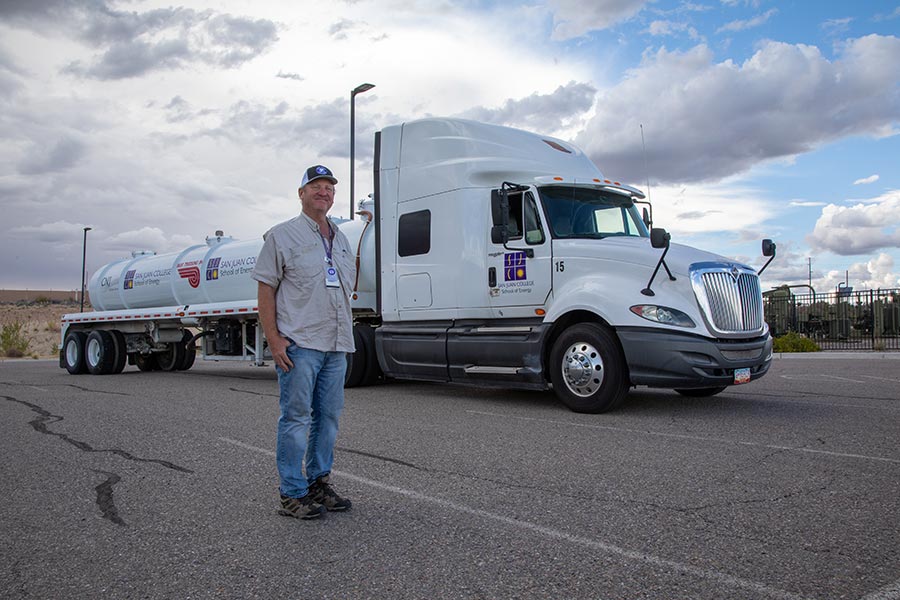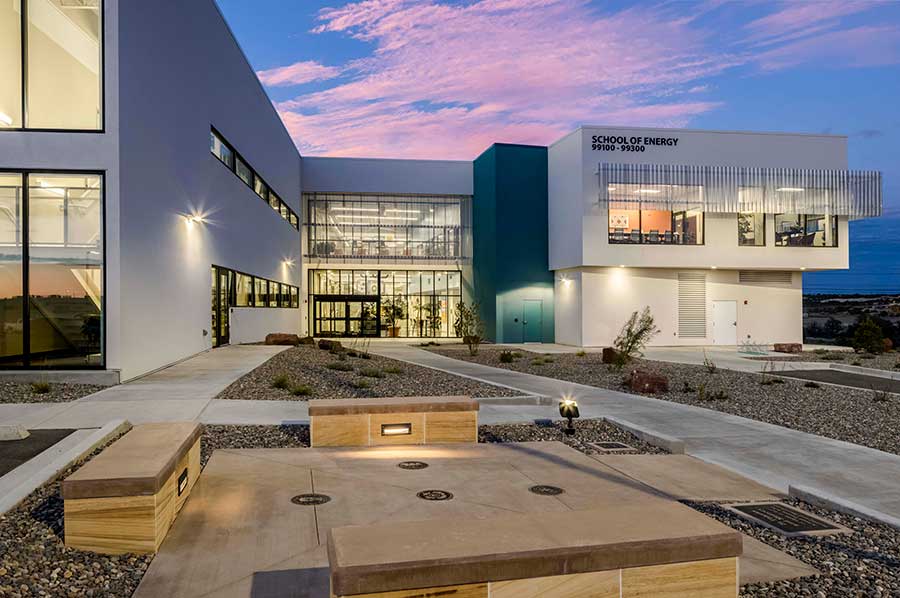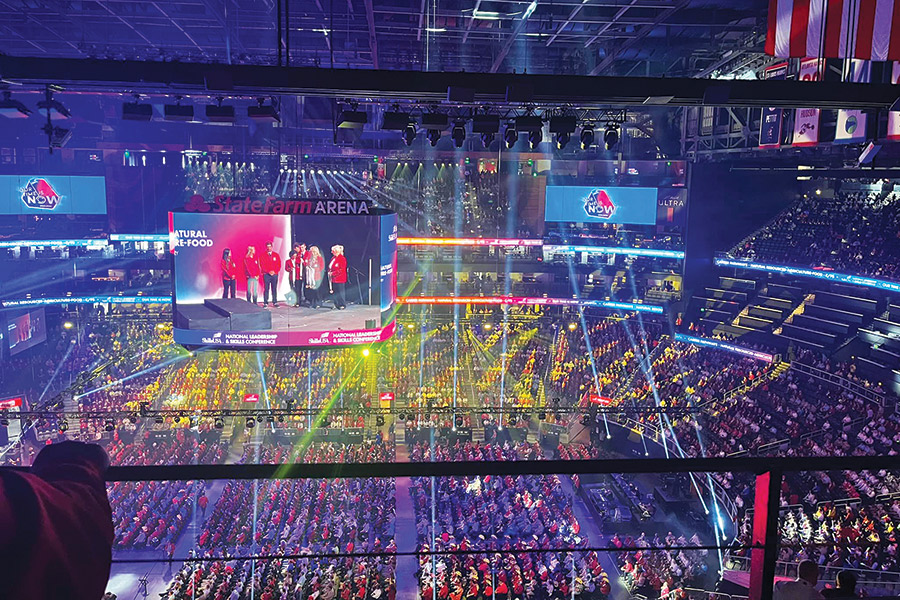Explore types of commercial driver's licenses (Class A, B, C), CDL training programs, and the step-by-step process for obtaining your CDL in New Mexico.

When you get your first driver’s license, you’re only allowed to drive personal vehicles. If you want to start a career driving commercial vehicles like semitrucks, buses, or garbage trucks, you’ll need a Commercial Driver’s License (CDL).
In the United States, commercial vehicle and truck drivers must earn a CDL because these vehicles are significantly larger, heavier, and more challenging to operate than passenger cars. Additionally, some drivers transport passengers or hazardous materials, creating higher safety standards and responsibilities.
Read on to learn about the types of commercial licenses, what you can drive with each, and information that will be helpful on your journey to working as a truck or commercial driver.
Jump to:
Understanding License Classifications
The Federal Motor Carrier Safety Administration (FMCSA) and state agencies like the New Mexico Motor Vehicle Division establish rigorous road safety standards for each type of vehicle. The difference between Class A, B, and C CDLs lies in the type of vehicle you can drive, how much it weighs, what it is towing, and how heavy the towed items are.
Before diving into specific licenses, it may be helpful to understand some terminology:
- Commercial Vehicle: Any vehicle used for business that meets certain weight requirements or transports passengers or hazardous materials.
- Gross Vehicle Weight Rating: The maximum operating weight of a vehicle, including the vehicle itself, fuel, passengers, and cargo.
- Towed Unit Weight: The weight of any trailer, semi-trailer, or other towed equipment.
- Gross Combination Weight Rating: The total weight of a vehicle and its tow load.
Class A CDL: Long-Haul Trucking
A Class A commercial driver’s license allows you to operate any vehicle or combination of vehicles or tow loads of 26,001 pounds or more, provided the towed unit weighs more than 10,000 pounds. This is the most comprehensive commercial license and opens doors to the highest number of driving opportunities in interstate long-haul trucking, often referred to as “over the road” (OTR) driving, which involves crossing state lines to deliver goods.
With a Class A CDL, you can legally operate:
- Tractor-trailers (also known as semitrucks or 18-wheelers)
- Truck and trailer combinations
- Tanker vehicles
- Livestock carriers
- Flatbed trucks
Endorsements, which are discussed in more detail below, are additional credentials that can be added to your Class A license to allow you to work in specific areas, such as the transport of hazardous waste.
Class B CDL: Local Delivery and Municipal Vehicles
A Class B CDL permits operation of single vehicles weighing 26,001 pounds or more, or any such vehicle towing another vehicle weighing up to 10,000 pounds. Unlike Class A, these vehicles typically have the cab and cargo area or passenger compartment as a single unit.
With a Class B CDL, you can legally operate:
- Straight trucks (single-unit trucks with a permanent cargo area)
- Large buses (including city transit buses)
- School buses
- Segmented buses
- Box trucks (like delivery or moving trucks)
- Dump trucks
- Garbage trucks
- Cement mixers
Class B drivers may drive local routes and return to their starting location daily. These positions frequently involve more customer interaction and may include duties beyond driving, such as making deliveries or providing passenger assistance.
Class C CDL: Smaller Commercial Vehicles
A Class C CDL covers commercial vehicles that don't meet Class A or B criteria but are designed to transport either passengers (16 or more, including the driver) or hazardous materials, like chemicals or biological material, as defined by federal regulations.
With a Class C CDL, you can legally operate:
- Passenger vans designed for 16+ passengers
- Small HAZMAT vehicles
- Combination vehicles not covered under Class A or B licenses
These positions often involve specialized transportation services, such as airport shuttles, small tour buses, farm equipment towing, or certain types of hazardous material transport.
What Are CDL Endorsements?
CDL endorsements are additional qualifications that permit drivers to operate specialized vehicles or transport specific types of cargo. Adding endorsements to your CDL can significantly increase your employability and earning potential, as they qualify you for specialized driving positions that often pay premium wages.
Obtaining an endorsement requires additional knowledge or skills tests. While most endorsements are added to Class A CDLs, many can also be added to Class B or C licenses depending on the specific vehicles you'll operate.
(P): Passenger Endorsement
A Passenger (P) endorsement permits you to drive vehicles designed to carry passengers, such as buses. This endorsement requires both knowledge and skills tests focusing on passenger safety, emergency procedures, and proper boarding/disembarking protocols.
Common vehicles requiring this endorsement include:
- Charter buses
- Municipal transit buses
- Tour buses
- Airport shuttles
(H): Hazardous Materials Endorsement
The Hazardous Materials (H) endorsement qualifies drivers to safely transport hazardous materials. Courses or independent study for this endorsement may require a knowledge test and a background check.
This endorsement is necessary for transporting:
- Flammable liquids
- Explosive materials
- Toxic or corrosive substances
- Radioactive materials
(N): Tank Vehicle Endorsement
The Tank Vehicle (N) endorsement permits the transportation of liquids or gases in tank vehicles, which are designed to transport liquid or gaseous materials within a permanent or temporary tank attached to the vehicle.
This endorsement requires a knowledge test focusing on the unique handling characteristics and safety considerations of tanker vehicles, including:
- Liquid surge and its effect on vehicle handling
- Center of gravity considerations
- Braking differences
- Emergency response procedures
(S): School Bus Endorsement
The School Bus (S) endorsement permits the operation of school buses to transport students. This specialized endorsement requires both the Passenger (P) endorsement as a prerequisite, plus additional knowledge and skills tests specific to school bus operation. Topics covered include:
- Loading and unloading procedures
- Emergency exit operation
- Railroad crossing procedures
- Student management
- Special safety considerations
Other Valuable Endorsements
Adding endorsements to your CDL can lead to opportunities for more specialized and higher-paying driving jobs. Other endorsements that you can add to a Class A, B, or C commercial license include:
- (T): Double/Triple Trailers: Permits the operation of vehicles pulling two or three trailers, requiring specialized knowledge of connection procedures and handling characteristics.
- (X): Combination Tank Vehicle/Hazardous Materials: This combination endorsement is required for transporting hazardous materials in a tank vehicle, effectively combining the H and N endorsements.
Requirements for Getting a CDL License
Age Requirements
The state government dictates minimum age requirements to get a CDL of any classification. You can expect to find age requirements like:
- 18 years or older for in-state commercial driving
- 21 years or older for commercial driving across state lines
- 21 years or older for hazardous materials transportation (regardless of whether crossing state lines)
Medical Requirements
H3: Medical Requirements
All CDL applicants must undergo a physical to obtain a Medical Examiner's Certificate from a healthcare provider registered with the Federal Motor Carrier Safety Administration. This examination assesses:
- Vision capabilities (20/40 vision in each eye with or without correction)
- Hearing abilities
- Blood pressure and cardiovascular health
- Physical ability to perform essential job functions
- Absence of conditions that could cause sudden incapacitation (such as untreated epilepsy)
- Absence of substance abuse issues
Medical certificates are usually valid for up to 24 months, though certain medical conditions may require more frequent recertification.
Drug and Alcohol Testing
CDL holders are subject to strict drug and alcohol testing requirements, including:
- Pre-employment
- Random testing during employment
- Post-accident or incident causing reasonable suspicion
All CDL holders will be registered in a database called the FMCSA Drug and Alcohol Clearinghouse. This database connects drivers to employers and state regulating bodies to track drug or alcohol violations.
New Mexico-Specific Requirements
In addition to federal requirements, New Mexico has specific criteria for CDL applicants. You must:
- Pass the required knowledge and driving tests with a score of 80% or higher
- Possess a valid New Mexico Class D non-commercial license or an active, valid out-of-state CDL
- Submit a current Commercial Driver Medical Certificate obtained from a medical professional
- Provide proof of United States citizenship or lawful permanent residence
- Demonstrate New Mexico residency
- Present personal identification documents
- Pass vision test
- Pay applicable fees
Certain endorsements, particularly Hazardous Materials (H), require additional background checks through the Transportation Security Administration. Visit the Motor Vehicle Division website for information on New Mexico’s CDL requirements.
How to Get a CDL License
1. Choose Your Class
The first step is determining which CDL class best aligns with your career goals. Consider:
- The types of vehicles you want to drive
- Whether you prefer local or long-distance routes
- Your interest in passenger transportation versus freight
- Your comfort level with different vehicle sizes and configurations
- Salary expectations and job availability in your area
To determine which CDL to pursue, research local job listings to identify the necessary license class and endorsements for the transportation positions you are considering.
2. Prepare for Permit Exam
Before you can begin behind-the-wheel training, you must obtain a Commercial Learner’s Permit (CLP) by passing written knowledge tests. Each state has a manual available that you can study, but local short-term training programs can significantly aid your preparation for the written permit test and certification driving tests.
Topics to learn for the written exam include:
- Commercial driving regulations
- Air brakes (if applicable to your vehicle class)
- Combination vehicles (for Class A)
- State-specific traffic laws and regulations
Most states require you to hold the CLP for at least 14 days before taking the skills test for your full CDL.
3. Complete Training
Once you have your permit, you must start hands-on training under the supervision of a current CDL holder in order to qualify for your full license. Whether through a formal CDL training program or with a qualified mentor, this training should cover:
- Vehicle inspection procedures
- Basic control (maneuvering, shifting, backing, parking)
- Space management
- Night operation
- Extreme driving conditions
- Emergency procedures
While you can study independently to earn your CDL, many employers prefer or require completion of certified truck driver training courses.
4. Pass Skills Test
The next step is performing a state commercial driving skills test in a vehicle in the same class as the license you’re pursuing. The CDL skills test varies by state, but it may consist of components such as:
- Vehicle Inspection Test: Evaluates your ability to conduct a thorough pre-trip inspection
- Basic Controls Test: How well you back up straight, on an angle, parallel park, and alley dock your vehicle
- Road Test: Driving in actual traffic conditions to demonstrate safe operation, signaling, changing lanes, railroad crossings, and general driving behavior
Types of CDL Training Programs
While it’s possible to study independently for the CDL knowledge and driving tests, most aspiring truck drivers benefit from formal training programs that offer structured classes, hands-on experience with actual vehicles, and expert instruction.
The timeline from starting the training program to obtaining your CDL can range from four to 12 weeks, depending on the program intensity and type of license or endorsements pursued. When choosing a CDL program, you have three main options:
Community College Programs
Community and trade college programs are best for comprehensive, affordable training with financial aid and maximum flexibility.
- Length: Several weeks to a few months
- Cost & Aid: Lowest cost and accepts financial aid
- Additional Info: Flexible scheduling for working adults, freedom to choose any employer after graduation
Truck Driving Schools
Privately owned truck driving schools are best for intensive training with job placement help.
- Length: Typically shorter, intensive programs
- Cost & Aid: Higher tuition than community colleges, limited aid, and some financing plans
- Additional Info: Often includes job placement assistance or partner employers
Trucking Company Programs
Transportation companies may offer free training in exchange for employment commitment after licensure.
- Length: Short, focused programs
- Cost & Aid: Free if the company pays all expenses; personal costs are not covered
- Additional Info: Must work for the sponsoring company for a minimum length of time and at a predetermined wage
Pursue CDL Licensure in New Mexico with SJC
Pursuing a commercial driver's license may seem complex, but CDL training programs like those at San Juan College (SJC) help you launch your driving career with assistance at each step, from initial prep to scheduling and taking exams.
Our eight-week Class A licensure certificate program provides thorough preparation for exams, including training for Class B licensing and passenger and hazardous materials transport endorsements. San Juan College also partners with the New Mexico Department of Workforce Solutions CDL Apprenticeship program, providing valuable career placement and opportunities for advancement after licensure.
Ready to start your journey toward a rewarding career in commercial driving? Learn more about our CDL Certificate Program today.



